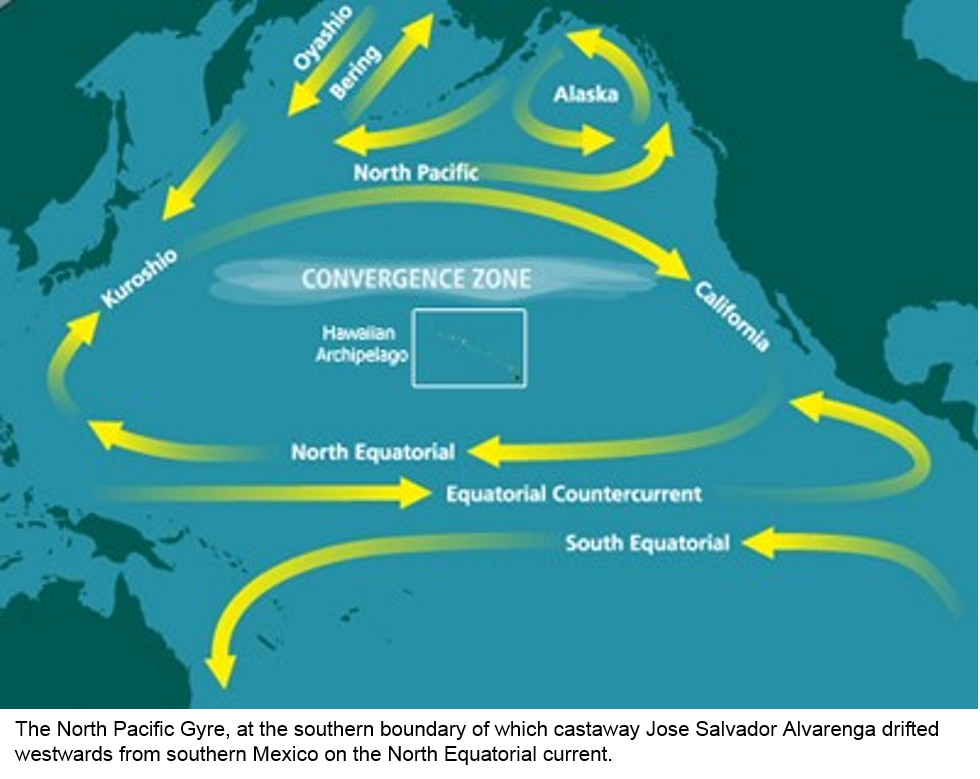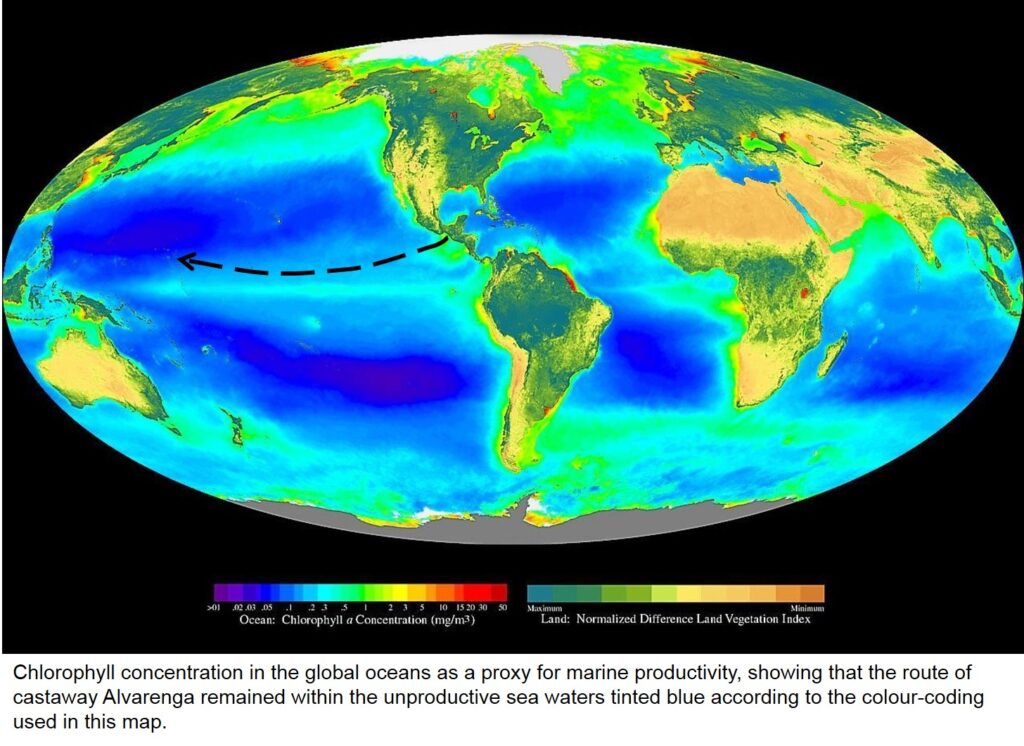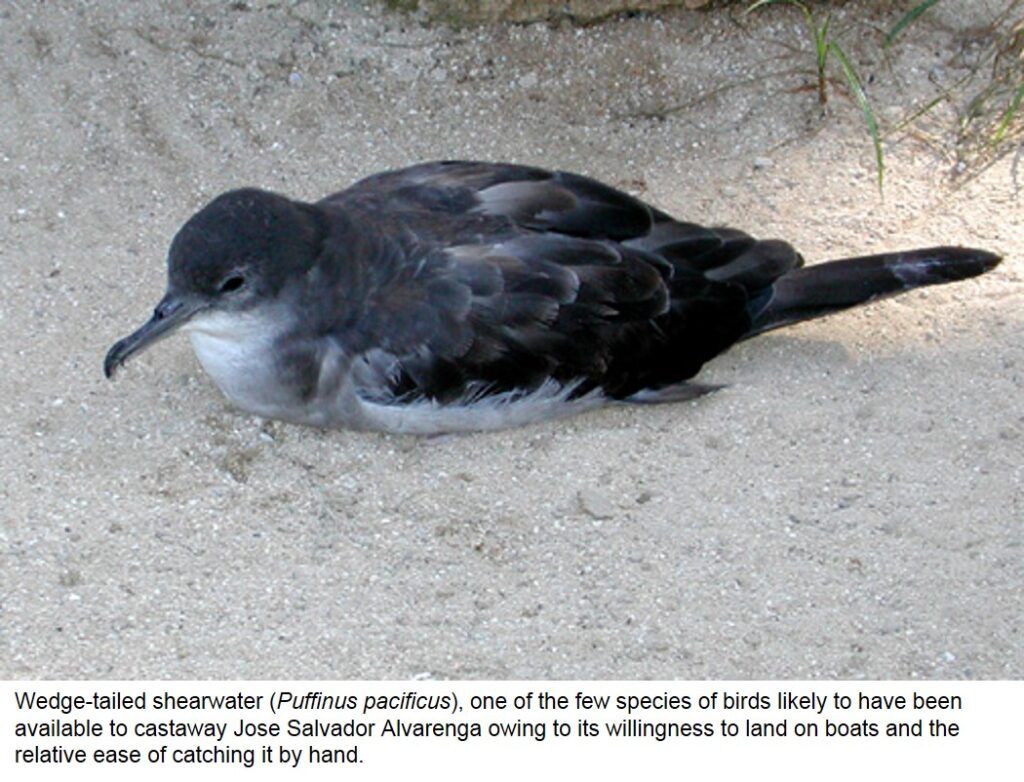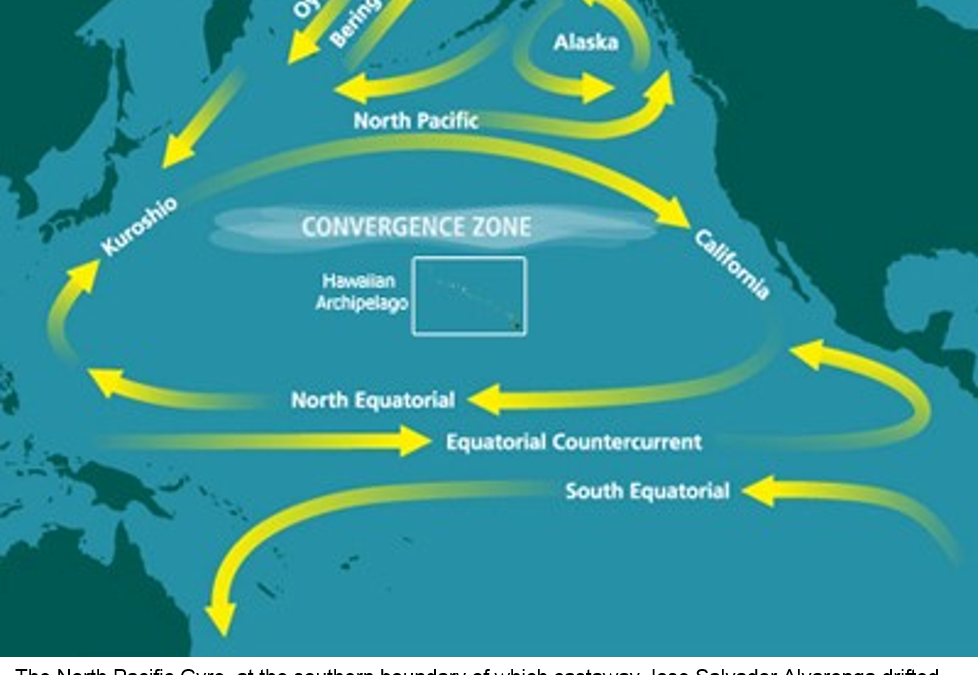The most famous castaway of all time, Jose Salvador Alvarenga, estimated age 37 years, has now returned to obscurity in central America. The media circus has moved on, ready for the next miracle. The limited information contained in news bulletins, with only superficial interpretation, may be the last we’ll hear of an uneducated fisher, speaking no English, and an illegal immigrant to Mexico from the even poorer El Salvador. Alvarenga was swept from the offshore waters 15 degrees north of the equator into the calm hell of the tropical Pacific for more than a year, turning up out of the blue in the Marshall Islands at the longitude of New Zealand on 30 January 2014.
So if there are any biological lessons to be learned from this case, there may be no better time to ponder them than now, at the end of February 2014.
The scientific mind will understandably tend to demur. An experimental sample of n = 1 defies analysis and the evidence is merely anecdotal. But the odder the evidence, the more our interest here at the Bio-edge. This is surely no hoax, and although the story is far-fetched all the attendant scepticism has been even more far-fetched. What we have here is an inadvertent biological experiment with a treatment so drastic that – even with all the rigour of a precise mind – it challenges important assumptions in biology.
Although beyond statistics this experiment is not beyond intelligent interpretation. Here’s a once-in-a-lifetime scientific opportunity which we should not overlook in our quest for the truths of human physiology.

Figure 1 [photo by AFP]
Consider the odds against Alvarenga. He was at sea for 14 months[1] in the tropics, in a small boat[2] with minimal equipment and shelter. He drifted month after month in a featureless sea with no map and no control, under the influence of the west-flowing North Equatorial current that defines the southern boundary of the North Pacific Gyre – and is known previously to have conveyed castaways from Mexico to Micronesia[3]. He was mostly alone because his sole companion[4] died early in the voyage. He had no drinking water other than rain pooled on the floor of his boat. His fishing gear was lost in the storm that cast him away in the first place, leaving only a knife and some fishing line; he was reduced to using a small turtle shell even to drink his own urine. For virtually the whole journey he had to catch all his food with his bare hands. All around him was a particularly nutrient-poor ocean with scant productivity of plankton at the base of its food pyramid. He was inevitably exposed to the elements most of the time, protected by a skin no darker than that of southern Europeans and paler than that of Pacific islanders. His part-Spanish origin shows in his complexion – more pallid than is typical for the native American side of his mixed ancestry – and in the ginger highlights in his sun- and salt-bleached hair.
Could these adversities be balanced by Alvarenga’s special strengths as an individual? In part, yes[5]. It is essential to understand that if anyone could be prepared for such a trial, Alvarenga was – because he had already been enduring the terrestrial equivalent of a castaway existence for half of his adult life.
In his native El Salvador, Alvarenga started going out to sea to fish when he was in his teens. When in his twenties, he was beaten and stabbed in a drunken brawl and left for dead. Although he unexpectedly recovered, he feared further reprisals and fled for the United States where several siblings have found a new life. He was stopped at the northern border of Guatemala and after deportation made a second attempt – only to find himself stranded and pesoless in self-imposed exile in rural southernmost Mexico. What followed was nearly a decade of living essentially as a rural and coastal hunter-gatherer, in a land already full of destitute people who could afford him no charity. The nickname given him in Chocohuital by his seasonal co-fishers, ‘The Sow’[6], tells of his acceptance of food scraps rejected by even the poor surrounding him. Unquestionably, here is a resourceful man with a sense of humour, used to making the most of the least. But neither his sturdy constitution and disposition nor his extensive ‘training’ in survival against the odds can fully explain how our castaway passed the ultimate test that was his year of solitary confinement in the widest of oceans.
Given the seemingly overwhelming adversities, the fact that Jose Salvador Alvarenga emerged from the Pacific in good health can only be explained if certain biological factors that seem adverse were actually favourable. Which could those be and which perceptions do we need to rethink? Let’s start with the minor surprises and work up to the major ones.
Our castaway showed no signs of deficiency in vitamin C when he chanced upon Ebon Atoll in the Marshall Islands on 30 January 2014. This shows that even a meagre diet of fresh, raw flesh – and it is said that the eyeballs of fish and birds are most valuable in this regard – can ward off scurvy. Here we have a notably clear-cut experimental result but no new concept.
Nor was he emaciated. A day or two after finding help, his appearance was already normal as can be seen in photographs of undoubted authenticity [http://www.dailymail.co.uk/news/article-2558005/Castaway-reveals-rescued-months-earlier-hellish-ordeal-saw-DOZENS-boats-screamed-help-just-waved-back.html]. We’ll probably never know how frequently Alvarenga caught food, but he must have gone long periods without eating. This is because his route followed the southern edge of the largest non-polar desert on Earth. Here the waters are downwelling instead of upwelling, and the nutrients essential to plankton are not brought into the photic zone where productivity of food can occur. The birds[7] he occasionally found were perhaps themselves desperate castaways after being swept off-course by storms.

Figure 2 [photo by Mary Ann Clark; Jung Choi; and Matthew Douglas]
How can we explain the hale if somewhat bewildered appearance of this man at the end of the experiment, with normal body mass for his height?
The fact that Alvarenga was not emaciated after 14 months of what must have been an extremely limited intake of energy shows that, during this experiment, energy was not the controlling resource. Alvarenga may happen to be an individual with extremely efficient digestion and a slow metabolism that became extremely slow in response to shortage of water, entering a sort of ‘Pacific torpor’. However, no previous castaway has shown so clearly the distinction between drought-induced torpor and starvation.
It seems possible that raw protein- and fat-rich animal matter, devoid of carbohydrates, was more valuable to our castaway than cooked food of more conventional composition would have been. Although it sounds inhuman, this diet may have been a healthy one given his lack of exercise and his depressed metabolism.
There is no doubt that Alvarenga suffered, in the first two weeks after returning to civilisation, from a long list of minor ailments: anaemia, slight oedema, slightly swollen liver and kidneys, low blood pressure and swollen leg joints, as well as mood swings, lapses of attention, and psychological withdrawal. However, he did not necessarily suffer from all of these symptoms during his voyage. Many may have resulted from the shock of a too sudden rehydration, a too eager acceptance of treats such as cola and pancakes, and a resumption of activity after such prolonged immobility. The body adjusts to restriction not only by psychological habituation, but also physiologically, for example by shrinkage of the gut and other organs. Our castaway’s symptoms during recovery could conceivably have been brought on by abrupt resumption of normal life rather than by his prolonged fasting, thirst, and inertia per se. And, after the initial euphoria of rescue, his patent psychological distress under bombardment by news agencies may have further undermined a physical condition that was feeble but sound at first landfall.

Figure 3 [photo by Mira Lumbye]
A big, although not the biggest, surprise is the healthy appearance of our castaway’s skin after more than a year in the tropical, and later equatorial, sun. Although it’s theoretically possible that Alvarenga spent all of his daytimes sitting under the blue plastic box [http://www.telegraph.co.uk/news/worldnews/australiaandthepacific/marshallislands/10616194/Castaway-from-Mexico-First-photos-of-Jose-Salvador-Alvarengas-boat.html ] that provided his only shade, and emerged mainly at night, it’s inconceivable that he would not have been exposed to ultraviolet radiation to a degree that many would expect to cause obvious symptoms. This is because his box would have been so uncomfortable that he would have resorted to it only for so long each day. It’s hard not to conclude from this experiment that even the olive skin of a partly native American but mostly Spanish genetic heritage is ample for protection from hours of daily exposure to a high sun, day after day. If so, where does our castaway’s glowing complexion leave the common assumption that only a dark brown colour can naturally provide protection from the brightest tropical sunlight? Or that Europeans need chemical sunscreen to keep the skin healthy in sunny climates? The answer: in the same tattered state as the boxer shorts that were Alvarenga’s last cloth by the time he spotted his first coconut palms.
If the darkest races are excessively adapted to ultraviolet radiation, how is their skin colour to be interpreted? Please see the bio-bullet we posted several months ago on this subject[8].

Figure 4 [photo by Wikipedia]
Which brings us to the biggest surprise of all: healthy kidneys after more than a year of what seems to have been continual and severe dehydration.
The Pacific can be rainy in wet seasons and in particularly wet years, and it’s easy to assume that Alvarenga chanced on enough rain to drink regularly. However, this doesn’t stand up to scrutiny. The eastern Pacific experienced only average rainfall during 2013, being in neither a wet nor a dry phase in terms of the La Nina-El Nino cycle. Although probabilities of rainfall in the open ocean are guesswork and this is particularly so in the remote Pacific, it seems fair to assume mean annual rainfall of 800 millimetres per year with seasonal drought, over most of his journey. This may sound like enough to live on, but he would have experienced no rain for most days during his 14 months, sometimes for weeks at a time. The most relevant information on rainfall is from the Line Islands[9] which hardly rise above sea level north of the equator in the central Pacific and which he passed unawares on his way to the Marshall Islands. The climate of this archipelago is known to be surprisingly dry for an equatorial location surrounded by water. Rain recorded on volcanic islands such as Hawaii and the Galapagos can be misleading because of the cloud-milking effects of topography. So the Pacific expanses crossed by Alvarenga are semi-arid[10] in the sense of available drinking water for much of the year, as well as being a semi-desert for food (i.e. in terms of population densities of harvestable fishes and resident birds).
Under the tropical sun, Alvarenga must have lost considerable water by sweating, even if he huddled all day under the box that provided his only shade[11]. And whatever rainwater collected on the floor of his boat would have evaporated in the full sun within days.
Given the circumstances, it’s likely that Alvarenga’s urine was dark most of the days of his ordeal. And that he drank much if not most of it anyway.
It’s understandable that news reports didn’t go into details about Alvarenga’s admission that he recycled his own urine. But here we have a compelling reason to question the real function of the kidney, an organ which for too long has been shoehorned into an implausible role as mainly excretory. Please see a soon-to-be-released bio-bullet on this topic[12].
It makes little sense to interpret the vertebrate kidney as devoted to excretion, based on the incongruous facts of its physiology. And this new evidence calls into further question the dogma that urine is essentially toxic. Indeed, Alvarenga’s experience implies that urine may be a beneficial beverage in certain circumstances particularly in terms of micronutrients, vitamins and antioxidants. Is it too far-fetched to suggest that one of the things that Alvarenga had going for him, as opposed to against him, was the value of urine? Or to be blunt: given that our castaway was in fasting mode with minimal exercise, urine was actually a superior drink to pure water?
Few components of urine are toxic as such, and the yellow liquid can be viewed as an overflow[13] of otherwise wholesome materials, superfluous to immediate needs. When the metabolism merely maintains life for a prolonged period and the essential flow of materials through the body can only be kept up by recycling what would normally be disgusting effluents, the ‘waste’ substances in urine may be effectively nutritious although having no energy value. Alvarenga’s anaemia may have been unavoidable because iron is excreted via bile and faeces, instead of passing through the kidneys. Since excretion tends to be proportional to consumption, a limited intake of both food and water and the routine recycling of urine may not, in fact, have toxic consequences even on a protein-rich diet. Of course, it can only help that Alvarenga’s environment was free of the pollutants of civilisation.
How did our castaway get rid of the salt that must have entered his body continually? The skin excretes salt and this function is not necessarily proportional to perspiration because the concentration of salt in sweat varies greatly. It’s hard to explain our castaway’s survival unless his skin assumed the main role in excreting sodium and his sweat, which was certainly of limited quantity, was extremely salty.
Has Jose Salvador Alvarenga single-handedly proved our common notion of the main function of the kidneys to be wrong? That would be going too far. But if we accept the facts of his case, we must surely acknowledge that we have yet to discover the overall process to which the kidney is really devoted, if this is not excretion. For it seems that the repeated analyses of our castaway’s urine – performed by incredulous doctors in the Marshall Islands and also on his return to El Salvador – consistently showed an unexpectedly clean bill of health for his kidney functions despite his complaints of some swelling and pain in that area. We should not allow one fellow to ‘take the piss’ out of scientific consensus, but we owe it to the textbooks of the future to take seriously one of the harshest of experiments to which a human being is likely ever to be subjected legally in the Information Age.
***
All text and images appearing in this blog are subject to copyright, except those images explicitly stated to be in the public domain. You are not free to use any photographs, for any purpose, without receiving written permission from the copyright holder.
1 Alvarenga was last seen when he set out to sea on 17 Nov. 2012, and was reported missing on 19 Nov. 2012.
2 7 m fibreglass dinghy
3 See http://en.wikipedia.org/wiki/Jes%C3%BAs_Vida%C3%B1a
4 Ezequiel Cordoba, age 23 years
5 There are remarkable resemblances between Jose Salvador Alvarenga and his predecessor Salvador Ordonez Vasques, the hero of a similar case in which three castaways were rescued as they approached the Marshall Islands in 2006 after drifting along a similar route from a point farther north on the Mexican coast. These include age (36-37 years old), short stature, ethnic and educational background (unschooled Meztiso), personality (modest, unflappable, resourceful), faith (non-churchgoing belief in God and the power of prayer), vices (regularly drunk on alcohol), experience (shark fishers, used to eating animals raw), and reaction to celebrity (disinterest in fame, wish to return to normality and to forget their trials).
6 translated from the dialectal Spanish ‘La Chanca’
7 One of the most informative of press reports is: http://www.dailymail.co.uk/news/article-2553717/Castaway-poor-forced-eat-dog-food-living-illegal-immigrant-Mexico-setting-ill-fated-fishing-trip.html
8 See our bio-bullet ‘What is the true adaptive value of human racial variation?’
9 in the Republic of Kiribati
10 A mean annual rainfall of 80 centimetres would mean an average of only 1.5 centimetres of fresh water collected on the salt-contaminated floor of his boat each week, which would soon evaporate in the tropical sun.
11 See photos of boat and box in: http://www.telegraph.co.uk/news/worldnews/australiaandthepacific/marshallislands/10616194/Castaway-from-Mexico-First-photos-of-Jose-Salvador-Alvarengas-boat.html
12 See our bio-bullet ‘What is the real power of a kidney?’
13 More than 99% of the material filtered into the renal tubules is promptly returned to the blood, so the drinking of urine can be seen as an extension of the internal recycling performed by the kidney in the first place.

